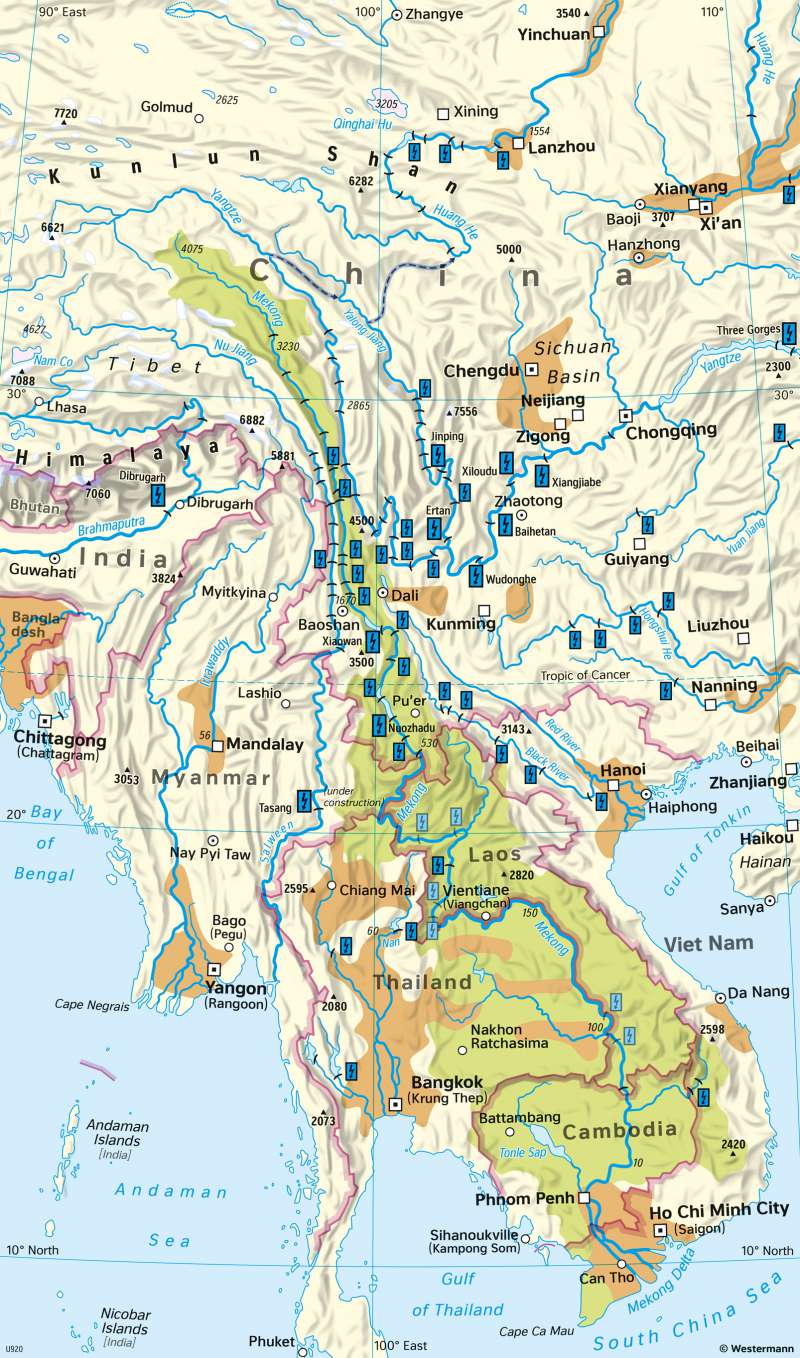Mekong River - Dams and power
Topographic orientation
978-3-14-100890-6 | Page 116 | Ill. 1

Overview
With a length of about 5,000 km, the Mekong River is the 12th longest river in the world. The Mekong basin covers an area of about 80,000 km² in six countries. From its source in the Tibetan Plateau to its mouth in Vietnam’s Mekong delta, the river is a habitat for about 20,000 plant species and 850 fish species. It is also home to more than 80 million people. Most of them do agriculture or aquaculture in the lower basin areas of Vietnam and Cambodia. In the upper basin, there is a rapid economic change, as there is an increasing amount of dams built. This has already changed the river valley of Southern China and Laos.
Distribution and significance of dams
The significance of hydro-electric power generation in the area shown in the map is high. The upper and middle section of the basin are mountainous, so the necessary relief energy is given. The climate is mostly mountain climate or tropical wet and dry, offering sufficient precipitation. Besides, the region is surrounded by the newly industrialised countries China, Thailand and Vietnam, which all have a growing need for power.
The map shows the distribution of dams in the area. Generally, the biggest and most dam projects are in the upper Mekong stretch in Southern China. Whereas in the high alpine regions of the Tibetan plateau, dams with a capacity of 500-3000 MW dominate the energy sector, the stations’ capacities become bigger near the border to Laos. There, a number of dams with a capacity of over 3000 MW is located. For energy production, Laos plays a special role. In the last two decades, about 25 dam projects were built and another 20 are in the planning or construction phase. The country’s potential for hydro-generated power is huge: in the mountainous East, precipitation is up to 2,000 mm. Moreover, due to the mostly agricultural lifestyle, the country’s power demand is low. Laos is and will be an important exporter of energy, giving the country the nickname “the Battery of South East Asiaâ€.
Effects on economy, population and ecology
The construction of dams has far-reaching effects for economy, population and ecology. In the upper Mekong basin, economy is booming due to the construction of dams which often goes along with an industrialisation and urbanisation of the sparsely-populated regions. However, on the side of ecology, the migration of fishes is limited. In the middle section of the Mekong, e.g. in Laos, the same effects persist. Additionally the local people and farmers partly give up their lifestyles, because they get jobs in the construction business or are re-settled from their agricultural villages along the rivers when dams are built.
The effects on the lower Mekong Basin are mostly in connection with the river’s water level. The graph at the bottom of the page shows that with more water being stored in the artificial lakes the water level has decreased. Also, there are less varying water levels in the dry and wet seasons. As the agriculture in the downstream regions is adapted to the water level, this water shortage has a big effect on the irrigated farmland. At times, the water to irrigate rice fields is missing so farmers cultivate other crops. Secondly, the soil quality has decreased as the fertile sediment are deposited in front of the dams and not brought to the fields anymore. So in the Mekong delta region, the use of chemical fertilisers has increased.
Effects on economy, population and ecology
The construction of dams has far-reaching effects for economy, population and ecology. In the upper Mekong basin, economy is booming due to the construction of dams which often goes along with an industrialization and urbanization of the sparsely-populated regions. However, on the side of ecology, the migration of fishes is limited. In the middle section of the Mekong, e.g. in Laos, the same effects persist. Additionally the local people and farmers partly give up their lifestyles, because they get jobs in the construction business or have to leave their villages along the rivers when dams are built.
The effects on the lower Mekong Basin are mostly in connection with the river’s water level. The graph at the bottom of the page shows that with more water being stored in the artificial lakes the water level has decreased. Also, there are less varying water levels in the dry and wet seasons. As the agriculture in the downstream regions is adapted to the water level, this water shortage has a big effect on the irrigated farmland. At times, the water to irrigate rice fields is missing so farmers cultivate other crops. Secondly, the soil quality has decreased as the fertile sediment are deposited in front of the dams and not brought to the fields anymore. So in the Mekong delta region, the use of chemical fertilizers has increased.
Author:
Christoph Zwissler




